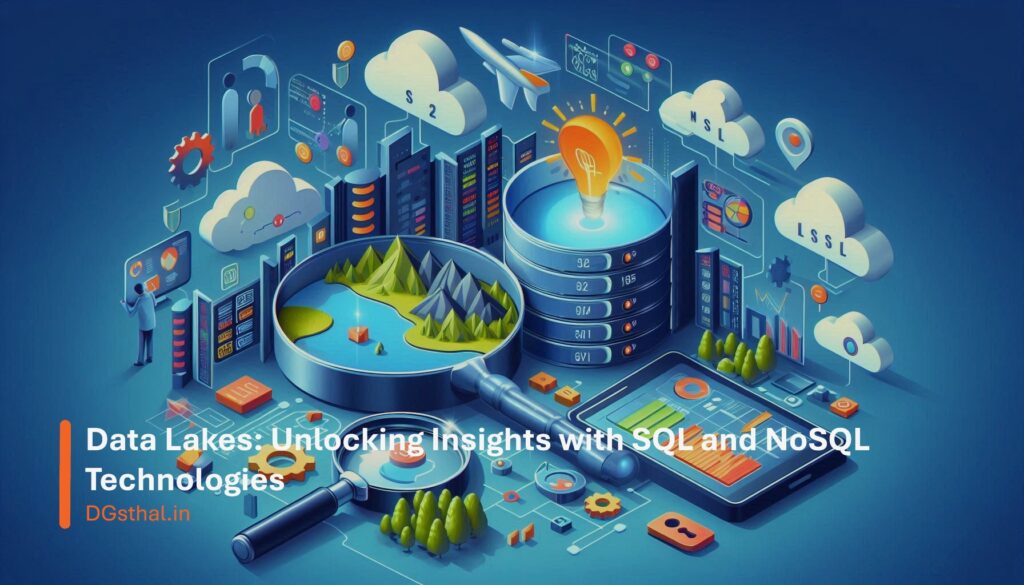Imagine a vast digital reservoir, brimming with raw, unprocessed data from diverse sources. This is the essence of a data lake, a modern data management approach that allows organizations to store and analyze data in its native format, regardless of its structure or type. But how do we navigate this data ocean and extract valuable insights? This is where the power of SQL and NoSQL technologies come into play, offering complementary tools for querying and analyzing data lakes.
This blog post will delve into the world of data lakes, exploring how SQL and NoSQL technologies empower organizations to unlock hidden patterns, make data-driven decisions, and gain a competitive edge. We’ll examine the unique strengths of each technology, the challenges they address, and how they work together to create a powerful data analytics ecosystem.
The Data Lake: A New Paradigm for Data Management
The traditional approach to data management often involved structured databases, where data was meticulously organized into predefined schemas. This approach, while effective for structured data, struggled to accommodate the explosion of unstructured and semi-structured data generated by modern applications, social media, sensors, and other sources. Data lakes emerged as a solution to this challenge, embracing a schema-on-read approach. This means that data is stored in its raw format, without predefined schemas, and is only structured when it’s queried or analyzed.
Think of a data lake as a digital repository for all your data, regardless of its source or format. It’s like a vast library, holding books, articles, reports, and even handwritten notes, all organized and accessible for future reference. This flexibility allows organizations to store data from various sources, including:
- Web logs: Track website traffic, user behavior, and online interactions.
- Social media data: Analyze trends, sentiment, and customer engagement on platforms like Twitter, Facebook, and Instagram.
- Sensor data: Monitor real-time conditions in industrial processes, environmental monitoring, and smart cities.
- Transaction data: Capture sales records, customer interactions, and financial transactions.
The ability to store diverse data types in a single repository offers several advantages:
- Reduced data silos: Eliminates the need to maintain separate databases for different data types, fostering a more unified and collaborative data environment.
- Increased data accessibility: Makes data readily available for analysis and exploration, empowering data scientists, analysts, and business users to discover new insights.
- Enhanced data governance: Provides a centralized platform for managing data quality, security, and compliance.
SQL: The Foundation of Structured Querying
Structured Query Language (SQL) has been the cornerstone of relational database management systems for decades. Its strength lies in its ability to manipulate and retrieve structured data efficiently. SQL queries are declarative, meaning they specify what data needs to be retrieved, leaving the underlying implementation details to the database engine.
In the context of data lakes, SQL shines when dealing with structured data sets or when applying analytical functions to semi-structured data that has been transformed into a relational format. For example, you can use SQL to query web logs to identify user trends, analyze sales data to identify customer segments, or join data from different sources to create a comprehensive view of customer behavior.
Here’s a simple SQL query to illustrate its power:
SELECT customer_name, order_date, total_amount FROM orders WHERE order_date >= '2023-01-01' AND order_date <= '2023-03-31' ORDER BY total_amount DESC;
This query retrieves customer names, order dates, and total amounts for orders placed between January 1st and March 31st, 2023, sorted by total amount in descending order. This simple query showcases the power of SQL to retrieve specific data sets and perform basic analysis.
NoSQL: Embracing Flexibility and Scalability
NoSQL databases, in contrast to SQL databases, are designed to handle unstructured and semi-structured data with greater flexibility. They offer a variety of data models, including key-value stores, document databases, graph databases, and column-family databases, each tailored to specific data types and use cases. NoSQL databases are known for their scalability, handling large volumes of data and high-throughput operations with ease.
In data lake scenarios, NoSQL databases excel in handling diverse data formats, such as JSON, XML, and text files. They allow for flexible schema definitions, making it easier to store and query data that doesn’t conform to traditional relational structures. For example, you can use a NoSQL database to store social media posts, sensor readings, or customer reviews in their native formats, without the need for complex data transformations.
Here’s a simple example of how a NoSQL database can store and query data:
{
"customer_id": "12345",
"name": "John Doe",
"email": "john.doe@example.com",
"orders": [
{
"order_id": "67890",
"date": "2023-02-15",
"items": [
{ "product_id": "101", "quantity": 2 },
{ "product_id": "102", "quantity": 1 }
]
}
]
}
This JSON document represents a customer profile, including their ID, name, email, and a list of orders. NoSQL databases allow you to query this data based on specific fields, such as customer ID or order date, providing flexibility in data access.
Bridging the Gap: SQL and NoSQL in Harmony
While SQL and NoSQL technologies offer distinct advantages, they are not mutually exclusive. In fact, they often complement each other in data lake environments, creating a powerful data analytics ecosystem. Organizations can leverage the strengths of both technologies to handle various data types and query needs.
Here are some common scenarios where SQL and NoSQL work together seamlessly:
- Data ingestion and transformation: NoSQL databases can be used to ingest raw data from various sources, while SQL can be used to transform and clean the data before loading it into a structured database for analysis.
- Data exploration and discovery: NoSQL databases can be used to quickly explore and analyze unstructured data, while SQL can be used to perform more complex analytical queries on structured data.
- Data visualization and reporting: Both SQL and NoSQL databases can be used to generate reports and visualizations based on the analyzed data.
For example, an organization might use a NoSQL database to store customer feedback from social media, then use SQL to analyze the sentiment of the feedback and identify areas for improvement. This combined approach leverages the strengths of both technologies to gain valuable insights from diverse data sources.
Challenges and Considerations
While data lakes offer numerous benefits, they also present some challenges that need to be addressed:
- Data governance and security: Ensuring data quality, security, and compliance in a data lake environment can be complex, requiring robust governance policies and security measures.
- Data discovery and access: Finding relevant data within a vast data lake can be challenging, requiring effective metadata management and data cataloging tools.
- Data processing and performance: Processing large volumes of data in a data lake can be computationally intensive, requiring optimized query engines and distributed processing frameworks.
Organizations need to carefully consider these challenges and implement appropriate solutions to ensure the success of their data lake initiatives.
The Future of Data Lakes: Emerging Trends
Data lakes are constantly evolving, with new technologies and trends emerging to enhance their capabilities. Some key trends to watch include:
- Cloud-based data lakes: Cloud providers are offering managed data lake services, simplifying data storage, processing, and analysis.
- Data lake analytics platforms: Specialized platforms are emerging to simplify data exploration, analysis, and visualization within data lakes.
- Artificial intelligence (AI) and machine learning (ML): AI and ML algorithms are being integrated into data lakes to automate data analysis, generate insights, and make predictions.
These advancements are poised to transform data lakes into even more powerful data hubs, enabling organizations to unlock deeper insights, drive innovation, and gain a competitive edge.
Conclusion:
Data lakes represent a paradigm shift in data management, empowering organizations to store and analyze vast amounts of data in its native format. SQL and NoSQL technologies play complementary roles in this ecosystem, providing tools for structured and unstructured data querying, analysis, and visualization. By leveraging the strengths of both technologies, organizations can unlock hidden patterns, make data-driven decisions, and gain a competitive edge in today’s data-driven world.



